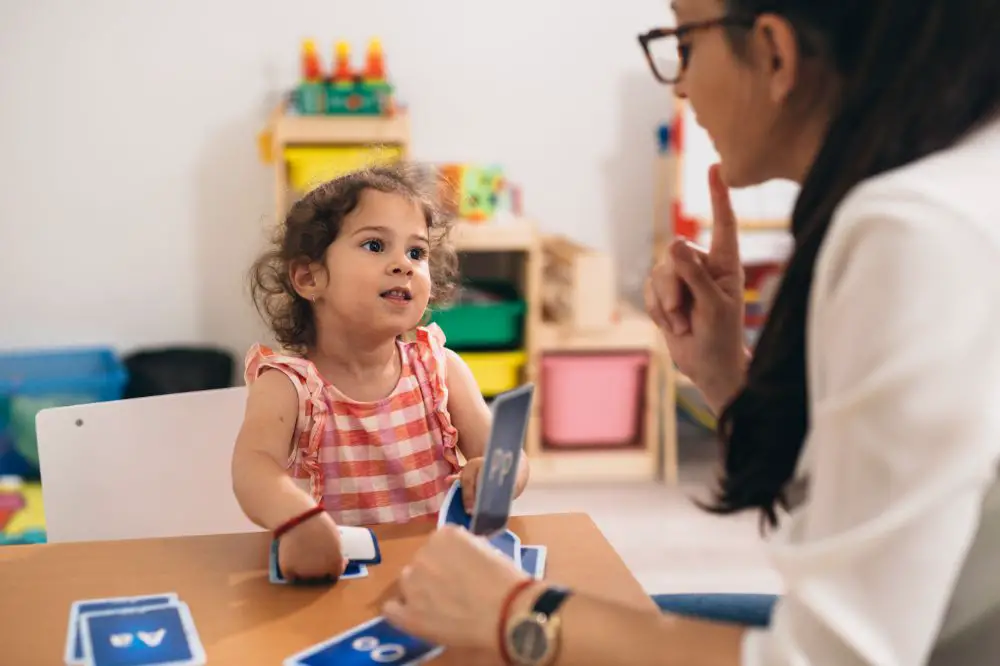As parents, we cherish those early moments when our children begin to communicate. But for some young kids, the path to clear speech can be filled with challenges. This is why speech therapy isn’t just a professional service; it is a lifeline for our little ones.
Below, we’ll talk about the crucial role parents play in this journey. Aside from that, we’ll also introduce you to Cycles Approach speech therapy, a gentle and effective approach to speech development.
This approach is designed to make speech therapy an empowering experience for both parents and their precious ones. It offers hope and guidance on the journey to clearer communication and stronger connections with your child.
Starting the Journey
Every parent eagerly anticipates their child’s first words. But when those words don’t arrive as expected, it can be a bewildering and sometimes worrying experience. Many parents have walked this path, feeling a mix of concern and determination.
Imagine a mother’s relief when she realizes her child’s speech delay isn’t an insurmountable obstacle but a bridge to greater communication. This is where the Cycles Approach enters the picture.
The Cycles Approach invites parents to be active participants in their child’s speech development journey. It transforms speech therapy into a shared experience, fostering a deeper connection and understanding between parents and their little ones.
Cycles Approach Speech Therapy

Speech therapy can sound daunting, especially when it involves young children. The Cycles Approach, however, is designed with both children and parents in mind, making it a user-friendly and effective choice.
What Is It?
Developed by Barbara Hodson, the Cycles Approach centers around creating a child-friendly and enjoyable environment for speech therapy.
It utilizes play-based activities, games, and stories that feel more like fun than therapy sessions. This child-centric approach can help ensure that kids actively participate and enjoy the learning process.
The Cycles Approach focuses on error patterns in speech. It identifies individual sounds or phonological patterns that a child struggles with, such as substituting one sound for another or omitting certain sounds.
The therapy then cycles through these patterns, providing targeted practice to improve speech sound accuracy.
Target Patterns and Secondary Patterns
In the Cycles Approach, target patterns or primary patterns are like the main speech challenges that therapists work on with your child. These are the toughest speech problems your child faces. Think of them as the big hurdles to overcome.
Secondary patterns are like the smaller hurdles. Once the big ones are tackled, the therapist focuses on these smaller issues to make your child’s speech even better. It’s like fixing the major potholes in a road before patching up the smaller cracks.
What Can Parents Expect From It?
When you opt for the Cycles Approach in your child’s speech therapy journey, you can look forward to several positive outcomes:
- Enhanced Speech Clarity: Over time, you’ll observe consistent improvements in your child’s target sound accuracy. Those tricky sounds that posed challenges will become more accurately produced.
- Boosted Confidence: As your child’s speech sound production gets better, their confidence in communicating will grow. They will be more eager to engage in conversations, express themselves, and interact with others.
- Improved Language Skills: The Cycles Approach doesn’t just focus on speech sounds; it also benefits overall language development in preschool children. Anticipate your child expanding their vocabulary and language skills.
- Strengthened Parent-Child Connection: Since parents actively participate in therapy sessions, this approach deepens the bond between you and your child. It’s a collaborative effort that fosters understanding and support, resulting in more intelligible speech.
Who Can Benefit From the Cycles Approach?
The Cycles Approach for children is a versatile and inclusive method that offers support and hope to a broad spectrum of children experiencing speech and language disorders. It serves as a valuable resource for parents looking to address their child’s communication development.
Among the candidates for Cycles treatment may include:
- Children exhibiting common phonological patterns (speech sound patterns) in early language development
- Those struggling with improvements in speech sound articulation, including initial consonants and consonant accuracy
- Youngsters facing challenges in substituting one sound for another or omitting specific sounds in their speech
- Children experiencing difficulty with the pronunciation of certain sounds or words
- Kids with word retrieval issues or trouble expressing their thoughts clearly
- Children with a limited vocabulary or challenges in understanding and following instructions
- Parents seeking a tailored approach to address their child’s speech and language hurdles
- Families in search of a child-friendly and engaging therapy approach to enhance communication skills in children
Key Components of the Cycles Approach
Understanding the Cycles Approach is vital for parents embarking on speech therapy for children with speech disorders. Let’s simplify its three key components using everyday examples:
Phonological Processes
Picture your child saying “wabbit” instead of “rabbit.” This is a common phonological process where one sound is substituted for another. The Cycles Approach identifies these target processes and helps your child work on improving the accuracy of nasal consonants and velars.
Target Selection
Think of target selection like planning a trip with a GPS. The speech therapist carefully selects which phonological patterns to work on based on your child’s needs. It’s akin to GPS guiding you to specific roads that need improvement during your journey to clearer speech.
Cyclical Treatment
Imagine this as the changing seasons in a year. Just as nature cycles through spring, summer, fall, and winter, the Cycles Approach cycles through the chosen speech patterns. This means revisiting and practicing these target processes to reinforce your child’s speech clarity.
With these components in mind, the Cycles Approach transforms the path to improved speech into a natural, nurturing process, much like tending to a garden.
You identify the trouble spots (phonological processes), decide which areas to nurture (target selection), and tend to them regularly (cyclical nature) to cultivate a garden of clear speech in children with speech disorders.
The Cycles Approach in Action
The Cycles Approach seamlessly blends playfulness and learning, creating an engaging adventure in speech therapy for preschool age children.
Active parental involvement is a key component, enhancing its effectiveness and ensuring therapy progress extends to everyday communication.
A Typical Session
Now, let’s delve into a typical therapy session to see how the Cycles Approach comes to life. In a cozy therapy room, your child may be seated at a small table with a speech therapist. The session typically kicks off with a warm-up activity, such as a game involving animal sounds.
Then, the therapist introduces the day’s focus of treatment, which could be working on a specific speech sound, like “r.” Fun props or toys, like a toy car, may be used to engage your child.
Through play and interaction, the therapist guides your child in practicing the correct “r” sound within words and sentences.
Active Parental Participation
As a parent, your role in the therapy process is pivotal. You can closely observe the session, learning how to replicate similar activities at home. The therapist might provide you with a list of common treatment methods and exercises to reinforce your child’s learning.
Encourage your child to practice the target sound during everyday activities, such as reading bedtime stories or playing with their toys. Your involvement not only solidifies their learning but also strengthens the parent-child bond.
Supporting Your Child
During therapy, your child may encounter moments of frustration or difficulty. As a parent, your support and encouragement can have a significant impact. Celebrate their small victories and offer comfort when they find certain sounds challenging.
By cultivating a positive and supportive environment, you help boost your child’s confidence and transform speech therapy into an empowering experience.
Activities At Home

Consistency plays a pivotal role in the success of interventions for speech sound disorders in children, particularly when employing the Cycles Approach. Alongside therapy sessions, creating a supportive and engaging home environment is equally crucial.
Here are practical activities and games that parents can effortlessly incorporate into their daily routines to reinforce therapy and enhance their child’s speech development:
Storytime with a Twist
Select books featuring the target sounds your child is working on. Encourage them to read along, emphasizing the correct sounds. For example, if the focus is on “s” sounds, choose stories with plenty of “s”-containing words.
Play I Spy
This classic game serves as an excellent tool. During daily activities, engage your child in I Spy. For instance, say, “I spy something that starts with the b sound.” This prompts them to identify and practice sounds in their surroundings.
Cooking Together
Transform meal preparation into a speech activity. Involve your child in simple tasks like stirring or naming ingredients. While doing so, emphasize the sounds being worked on. For example, if it’s the “k” sound, say, “Can you pass me the “k”arrot?”
Treasure Hunt
Craft a treasure map with clues that include words containing the target sound. As your child follows the map, they will have a blast while practicing their speech.
Sound Scavenger Hunt
Embark on a sound scavenger hunt around your home or neighborhood. Seek out objects or items that begin with the target sound. Create a list and discuss them together.
Silly Rhymes
Challenge your child to invent playful rhymes with the target sound. For instance, if it’s the “p” sound, they might create “purple pickle” or “playful puppy.”
Speech Jar
Establish a speech jar filled with small incentives like stickers or mini toys. Whenever your child successfully incorporates the target sound into a sentence during spontaneous speech, they earn a reward from the jar. This adds a positive reinforcement element to their speech development journey.
Parental Challenges in Cycles Approach Speech Therapy
The Cycles Approach shows promise in enhancing the accuracy of target patterns and promoting speech proficiency in school-age children. Still, it’s essential to acknowledge and address the challenges parents may encounter throughout this treatment program:
- Patience and Persistence: Speech therapy can be a gradual process, and parents may occasionally feel impatient. It’s crucial to remember that progress often comes in small steps, and maintaining persistence is key to achieving success.
- Frustration: Both parents and children may experience frustration when confronted with speech difficulties. Parents can offer crucial support by maintaining a positive and encouraging atmosphere, emphasizing effort over perfection.
- Time Commitment: Some parents may find it challenging to integrate speech practice into their daily routines. But setting aside dedicated time for speech activities can significantly impact a child’s performance during the treatment.
- Balancing Expectations: While the Cycles Approach is effective, it may not yield immediate, dramatic results. Parents should celebrate each small victory and recognize that progress during treatment is a unique journey for each child.
- External Pressures: Parents might encounter pressure from well-meaning friends or family members who anticipate rapid progress. Effective communication with the support network is essential, explaining the nature and timeline of the treatment.
- Addressing Emotional Needs: Children may have emotional reactions to speech challenges. Parents can address these needs by fostering a safe and open environment for communication, ensuring the child feels valued and loved.
Remember, every child’s journey toward improved speech accuracy and proficiency is unique. By approaching these challenges with patience, persistence, and a positive mindset, parents can empower their children to overcome speech difficulties.
Empowering Your Child’s Voice
The Cycles Approach offers not just a therapy method but a pathway to empowerment. Embrace the small victories, manage expectations, and persist with patience.
Take an active role in your child’s speech development, for it’s a partnership where your love, guidance, and support make all the difference. The laughter, the stories, and the moments of shared understanding—they all begin with the power of words.
With the Cycles Approach and your unwavering dedication, you’re not just helping your child speak. You are helping them find their voice and their place in the world.

